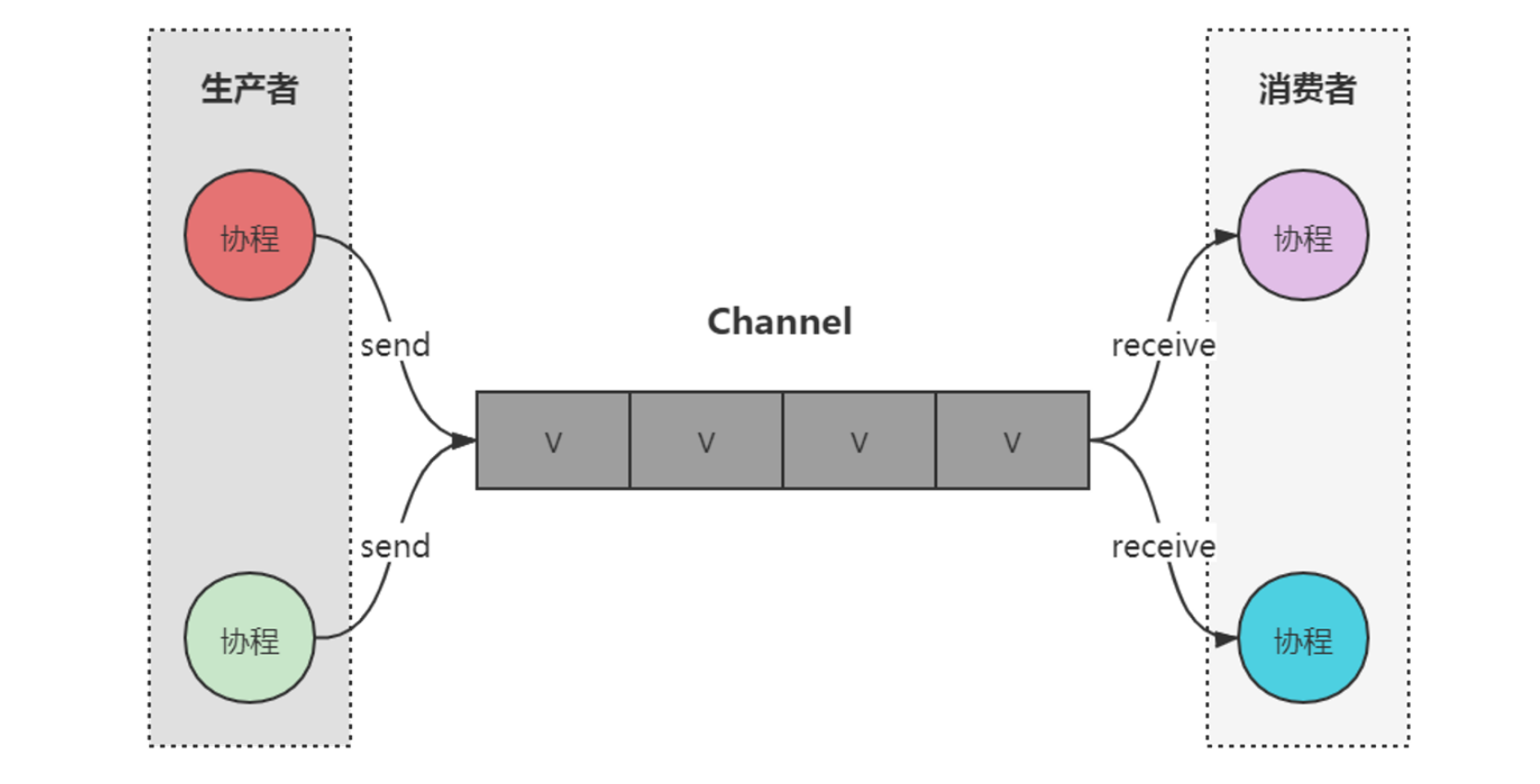一、Channel
Channel相较于Flow,Flow是冷流,本质上可以说是一个单线程操作,只有开始收集时,上流代码才会启动,而Channel是一个并发安全的队列,可以用来连接不同的协程,实现不同协程之间的通信

1.Channel的使用
创建一个Channel对象,在不同协程中调用其send和receive函数
fun `test channel`() = runBlocking {val channel = Channel<Int>()var isFinished = false//生产者val producer = GlobalScope.launch {var i = 0while (i < 3) {delay(200)//发送产品channel.send(++i)}isFinished = true}//消费者val consumer = GlobalScope.launch {while (!isFinished) {//接收产品println(channel.receive())}}joinAll(producer, consumer)
}结果:
1
2
3
2.Channel的容量
Channel的容量或者说缓冲区大小,默认为0,当消费者消费慢了,那么生产者会等待,反之生产者生产慢了,消费者会等待。如果想要指定缓冲区大小,可以在构建时传入
3.Channel迭代器
除了使用receive函数外,Channel还提供了迭代器用来接收数据
fun `test channel iterator`() = runBlocking {val channel = Channel<Int>(Channel.UNLIMITED)val producer = GlobalScope.launch {for (i in 0..5) {channel.send(i)}}val consumer = GlobalScope.launch { val iterator = channel.iterator()while(iterator.hasNext()){val element = iterator.next()println(element)}// for(value in channel){
// println(value)
// }}joinAll(producer,consumer)
}4.produce与actor
在协程中,可以使用produce启动一个生产者协程,并返回ReceiveChannel
fun `test channel produce`() = runBlocking {val receiveChannel = GlobalScope.produce {repeat(3){delay(100)send(it)}}val consumer = GlobalScope.launch { for(i in receiveChannel){println(i)}}consumer.join()
}反之使用actor启动一个消费者协程
fun `test channel acotr`() = runBlocking {val sendChannel = GlobalScope.actor<Int> {while (true) {delay(100)println(receive())}}val producer = GlobalScope.launch {for (i in 0..3) {sendChannel.send(i)}}producer.join()
}5.Channel的关闭
produce和actor返回的channel都会随着对应协程执行结束后自动关闭
我们也可以使用close方法手动关闭,它会立即停止发送元素,此时isClosedForSend会立即返回true,而由于缓冲区的存在,所有元素读取完毕后,isClosedForReceive才会返回true
fun `test channel close`() = runBlocking { val channel = Channel<Int>(3)val produce = GlobalScope.launch {for (i in 1..3) {channel.send(i)}channel.close()println("produce isClosedForSend: ${channel.isClosedForSend}" +" isClosedForReceive: ${channel.isClosedForReceive}")}val consumer = GlobalScope.launch {for (i in channel) {delay(100)println(i)}println("consumer isClosedForSend: ${channel.isClosedForSend}" +"isClosedForReceive: ${channel.isClosedForReceive}")}joinAll(produce, consumer)
}结果:
produce isClosedForSend: true isClosedForReceive: false
1
2
3
consumer isClosedForSend: trueisClosedForReceive: true
6.BroadcastChannel
kotlin还提供了发送端一对多接收端的方式,使用BroadcastChannel需要指定其缓冲区大小,或使用Channel.BUFFERED。还可以使用channel对象的broadcast函数来获取BroadcastChannel对象
fun `test channel broadcast`() = runBlocking {
// val broadcastChannel = BroadcastChannel<Int>(Channel.BUFFERED)val channel = Channel<Int>(3)val broadcastChannel = channel.broadcast()GlobalScope.launch {(0..3).forEach {broadcastChannel.send(it)}broadcastChannel.close()}List(3) { index ->GlobalScope.launch {val channel = broadcastChannel.openSubscription()for (i in channel) {println("index : $index receive: $i")}}}.joinAll()
}结果:
index : 1 receive: 0
index : 1 receive: 1
index : 1 receive: 2
index : 1 receive: 3
index : 0 receive: 0
index : 2 receive: 0
index : 2 receive: 1
index : 2 receive: 2
index : 2 receive: 3
index : 0 receive: 1
index : 0 receive: 2
index : 0 receive: 3
Process finished with exit code 0
二、多路复用
数据通信系统或计算机网络系统中,传输媒体的带宽或容量往往会大于传输单一信号的需求,为了有效利用通道线路,希望一个信道同时传输多路信号,这就是多路复用技术
1.多个await复用--select
获取数据可能有多个方法,每个方法的耗时可能不太一样,调用这些方法后,我们希望哪个方法先返回就使用它的返回值
data class Response<T>(var data: T, var random: Long)fun CoroutineScope.getInfoForLocal1() = async {// 随机一个等待值val random = (0..201).shuffled().first().toLong()delay(random)Response("info for local1", random)
}fun CoroutineScope.getInfoForLocal2() = async {// 随机一个等待值val random = (0..201).shuffled().first().toLong()delay(random)Response("info for local2", random)
}fun `test await select`() = runBlocking {val local1 = getInfoForLocal1()val local2 = getInfoForLocal2()val select = select<Response<String>> {local1.onAwait { response ->response //可以改成其他类型的}local2.onAwait { response ->response}}println("$select")
}结果:
Response(data=info for local1, random=56)
2.多个Channel复用
和await差不多
fun `test channel select`() = runBlocking {val channels = listOf(Channel<Int>(), Channel<Int>())GlobalScope.launch {delay(50)channels[0].send(0)}GlobalScope.launch {delay(100)channels[1].send(1)}val select = select<Int> {channels.forEach {it.onReceive { value ->value}}}println(select)delay(1000)
}结果
0
3.SelectCause
并不是所有的事件可以使用select的,只有SelectCauseN类型的事件
1.SelectCause0:对应事件没有返回值,例如join,那么onJoin就是SelectCauseN,使用时,onJoin的参数是一个无参函数
2.SelectCause1:对应事件有返回值,例如onAwait,onReceive
3.SelectCause3:对应事件有返回值,此外还要一个额外参数,例如Channel.onSend,一个参数为Channel数据类型的值,一个为发送成功时的回调
SelectCause3:
fun `test channel send select`() = runBlocking {val channels = listOf(Channel<Int>(), Channel<Int>())launch {select<Unit?> {launch {delay(100)channels[0].onSend(0) {println("onSend 0")}}launch {delay(50)channels[1].onSend(1) {println("onSend 1")}}}}GlobalScope.launch {println(channels[0].receive())}GlobalScope.launch {println(channels[1].receive())}}结果:
1
onSend 1
4.使用Flow实现多路复用
fun `test flow merge`() = runBlocking {listOf(::getInfoForLocal1, ::getInfoForLocal2).map { function ->function.call()}.map { deferred ->flow { emit(deferred.await()) }}.merge().collect {println(it)}
}结果:
Response(data=info for local1, random=129)
Response(data=info for local2, random=145)
和select不同的是,Flow收集时,会收集所有结果
三、并发安全
在Java平台上的kotlin协程实现避免不了并发调度的问题,因此线程安全值得留意
fun `test sync safe1`() = runBlocking {var count = 0;List(1000) {GlobalScope.launch { count++ }}.joinAll()println(count)
}结果:
987
当然我们还可以使用Java是提供的线程安全类
fun `test sync safe2`() = runBlocking {var count = AtomicInteger(0);List(1000) {GlobalScope.launch { count.incrementAndGet() }}println(count.get())
}协程框架也提供了解决并发问题的方法:
1.上面学习的Channel
2.Mutex:轻量级锁,用法和Java的锁类似,获取不到锁时,不会阻塞线程,而是挂起等待锁的释放
fun `test sync mutex`() = runBlocking {var count = 0;val mutex = Mutex()List(1000) {GlobalScope.launch {mutex.withLock {count++}}}.joinAll()println(count)
}3.Semaphore,轻量级信号量,在linux中是进程间通讯的一种方式,协程获取到信号量后即可执行并发操作。当Semaphore为1时,效果等价于Mutex
fun `test sync semaphore`() = runBlocking {var count = 0;val semaphore = Semaphore(1)List(1000) {GlobalScope.launch {semaphore.withPermit {count++}}}.joinAll()println(count)
}4.我们也可以避免访问外部变量,基于参数作运算,通过返回值提供运算结果
fun `test sync avoid`() = runBlocking {var count = 0;count += List(1000) {GlobalScope.async {1}}.map {it.await()}.sum()println(count)
}